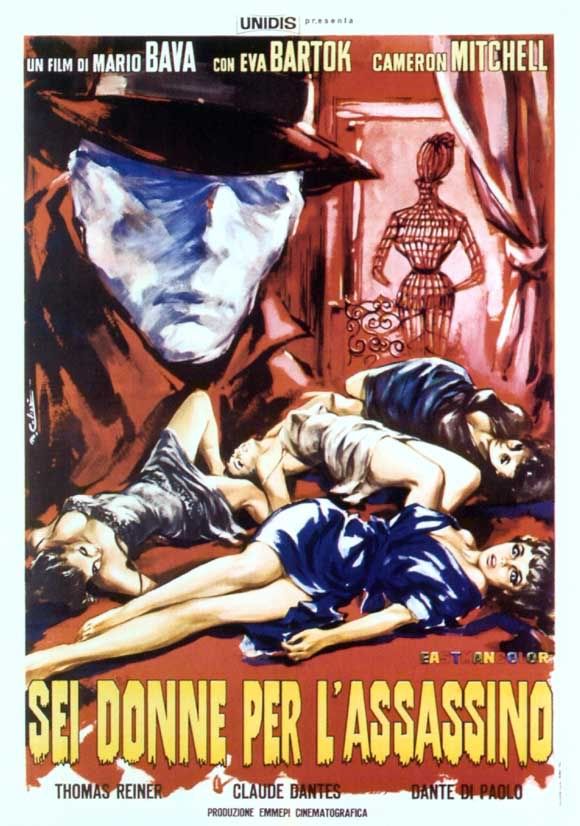(I guess this is what they mean when they say someone is “dressed to kill“…)

CAST: Cameron Mitchell, Eva Bartok, Ariana Gorini, Dante DiPaolo, Thomas Reiner, Mary Arden, Franco Ressell, Claude Dantes, Lea Lander, Francesca Ungaro.
DIRECTOR: Mario Bava
WARNING: Some SPOILERS and some pretty strong arguments against being a fashion model in Italy, straight ahead…
Our last review was Italian auteur Dario Argento’s semi-classic OPERA, which told the tale of a masked killer pursuing an opera singer during a Giuseppe Verdi-flavored production of Macbeth. That film, as well as the rest of Argento’s body of work, pretty much proved that Italy isn’t always a land of sunshine, beautiful cities, gorgeous people, and scrumptious food. Sometimes, it’s a fucking scary place. And our next review pretty much affirms this, the 1964 Mario Bava classic, SEI DONNE PER L’ASSASSINO. Or, in English, SIX WOMEN FOR THE KILLER.
Anyhow, I figured I’d choose a couple of scary Italian flicks to have nice, rounded selection for Cinema Italiano Week. But don’t worry… tomorrow, with the excellent love story LA FINESTRA DI FRONTE as our next review, we go back to the Italy we know and love - you know, the one filled with glowing sunlight, mouth-watering pasta, beautiful women with huge tits and golden-brown eyes, and hunks with endless tufts of chest and belly hair that you just want to rub for good luck - all of whom want nothing more than to have a good time. Thank goodness, too, because I don’t think I can take another movie where almost everyone is dead at the end…
SEI DONNE PER L’ASSASSINO’s title in America is BLOOD AND BLACK LACE, which is also appropriate, since it deals with a killer knocking off fashion models at an Italian atelier one by one in order to conceal an explosive secret. Let’s just say that SCREAM and its sequels are just the latest in a long line of horror films where it doesn’t pay to be beautiful. It usually almost always means you will be fleeing from some masked psycho with a very sharp knife. And, as usual, the Italians invented it first.
Our setting is the elegant and prestigious Como Fashion House, headed up by the Countess Christina Como (Eva Bartok), a woman whose face is so impassive you have to wonder if the Italians weren’t really the ones who secretly invented Botox decades ago and didn’t share it with the rest of the world until recently. Suffice it to say, it’s a good thing the Countess isn’t a model herself, otherwise she’d have a total of only 2 expressions to use during photo shoots. Not exactly job security, if you asked me.
Anyhow, the Countess oversees a whole flock of models with colorful personalities: (1) Isabella (Francesca Ungaro), who - if her fellow models are to be believed - is basically the biggest busybody this side of the Atlantic; (2) Nicole (Ariana Gorini), another busybody who’s dating some furniture store owner (WHAT? Hasn’t this bitch heard that models are supposed to date musicians or other models? A FURNITURE STORE OWNER?!? WTF???); (3) Peggy (Mary Arden), American model who is - yes - another busybody; (4) Greta (Lea Lander), another model who is - oh, why not - yet another busybody; and (5) Clarice (Harriet Medin), the only model who is not a busybody and is named after a kick-ass heroine from a horror movie that won’t come out for another, oh, 24 years (cough, cough, SILENCE OF THE LAMBS, cough, cough).
There are a bunch of other lovely, lovely models, but the above five chicks (plus the Countess) are the titular six women whom the killer declares open season on. It all starts when Isabella gets her fine ass sliced like a halibut by a masked killer on her way to a fashion show. Once her fellow models and the higher-ups at the atelier find out about her untimely demise, they pretty much freak the fuck out. But not as much as when they find out that - GASP! - Isabella kept a diary and was documenting all of her pals’ dirty secrets. As you can imagine, this goes over with that crowd about as well as the news that they’ve somehow contracted syphilis from the clothes they model. Hmmm… seems like someone’s been naughty - and Isabella knew all about it.
Before you know it, everyone is trying to get their hands on that diary. And, apparently, someone is also willing to kill for it, because soon Isabella’s murder is followed by another, then another, then another, then another. Before long, the Como Atelier is starting to look a lot like a Ghost Town - only a lot more stylishly decorated (this is Italy, after all). If this shit keeps up, there won’t be anyone left to model the clothes but the mannequins themselves.
Who is the killer? And why is she (he?) so intent on getting that diary? What did she (he?) do that would be worth killing people for? Is it Nicole? Peggy? Greta? The Countess? Clarice? Or one of their boyfriends? Or is it one of the cops investigating Isabella’s murder? For the love of Giorgio Armani, who is it?!?!
Personally, I think it’s Raoul Bova. Now those are some killer looks. He can kill me any day… And since I just spent the most of last week with a visiting friend who looks just like him, I know what I’m talking about…

Yes. Very yes.
BUT, SERIOUSLY: There are many who argue whether or not Dario Argento or Mario Bava is the true creator of the Giallo Genre. The Giallo is a type of Italian film that has some immutable characteristics: (1) an innocent lead - usually a foreigner - living in Italy who is plunged into a sinister mystery; (2) a vicious killer who will stop at nothing to protect a dark secret from coming to light; (3) colorful, almost beautiful setpieces that turn fear and mayhem into works of art; and (4) a revelation of whodunit that often comes from left field.
Sound familiar? These elements are present in everything from the original HALLOWEEN all the way to the recent SCREAM 4. Bottom line: regardless of who did what first, both Bava and Argento introduced a formula that has been copied over and over again and will likely continue to be so. Bava probably first introduced the template with THE GIRL WHO KNEW TOO MUCH and SEI DONNE PER L’ASSASSINO, but Argento unquestionably refined the rules that would give birth to the modern slasher film, leading to future hits like FRIDAY THE 13th, HALLOWEEN, PROM NIGHT, SCREAM, and their sequels.
Mario Bava’s direction epitomizes “style over substance” - but what style. He turns the movie’s settings into a nightmarish funhouse of shifting shadows and light, making everything and everyone a threat. Indeed, there is a constant feeling of danger to SEI DONNE, which never lets up until the final frame. No one and nobody is safe, which is a stark difference from a lot of later slasher films where the leads seem to be guaranteed safe passage through the film’s events by virtue of their billing. This has the effect of keeping us on our toes.
There are a lot of great setpieces here: (1) Isabella’s encounter with the “assassino” at the opening; (2) Nicole’s harrowing chase through the furniture store which clearly inspired a similar sequence in the underrated 1983 film CURTAINS; and (3) the final revelation of whodunit - which makes perfect sense when you think about it. SEI DONNE basically gave us some of the most creatively frightening sequences that very few of its progenitors have managed to come close to matching.
The only thing that keeps SEI DONNE PER L’ASSASSINO from rating higher is that we don’t really get a single character to identify with and follow through the film. Most of the models are either unlikable or killed off before we get too attached to them. The only character who really remains alive until close to the end is the Countess, and she is either too under-developed or portrayed as too unsympathetic for us to really root for. It doesn’t help that most of the acting is somewhat wooden, with some rather weak dialogue.
What elevates SEI DONNE PER L’ASSASSINO, in the end, is its sheer confidence and style. Those are both intrinsically Italian traits, and this film has it in abundance - enough to make up for its many glaring flaws. The result is a movie that has been much imitated - but has few peers in terms of sheer cinematic bravura.